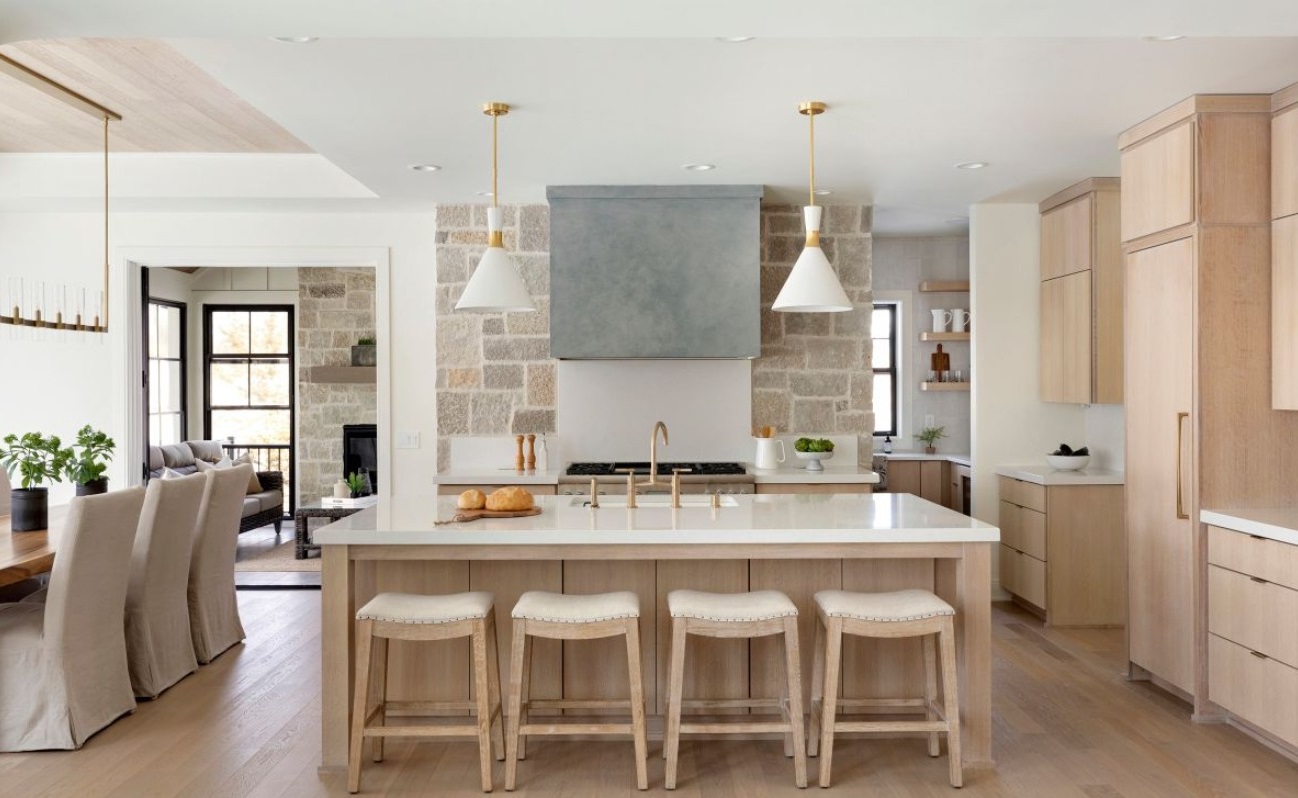Simple, attractive, and functional—a Scandinavian–style kitchen can do many things at once. It is elegant and exudes Nordic hospitality. That’s why people love sitting, cooking, and eating in Scandi kitchens. We show you how to bring chic style to your home.
This trend is here to stay: the Scandi-look kitchen exceeds your desire for a kitchen. Inspired by the “Hygge” lifestyle, Scandinavian-style kitchens are very comfortable, don’t require much fss, and rely on straight shapes. This makes Scandi kitchens timeless and ensures that you feel like you’re in the kitchen with Nordic-inspired furniture, never getting bored. Find out here what colours, materials, and decorations make up a Scandinavian kitchen and how you can achieve that look with the right steps!
A little style review: What is Scandi Style?
If you believe the UN World Happiness Report, Danes are among the happiest people in the world. But why does this happen, and how can we apply this attitude to our home lives? The secret lies in your attitude towards life and your opinion about the situation.
Danes love comfort, spending much time with their loved ones, and making every moment “hyggelig.” Hygge can also be integrated into everyday life and living spaces. To do this, you internalize the magic word “slow down” and combine it with comfort.
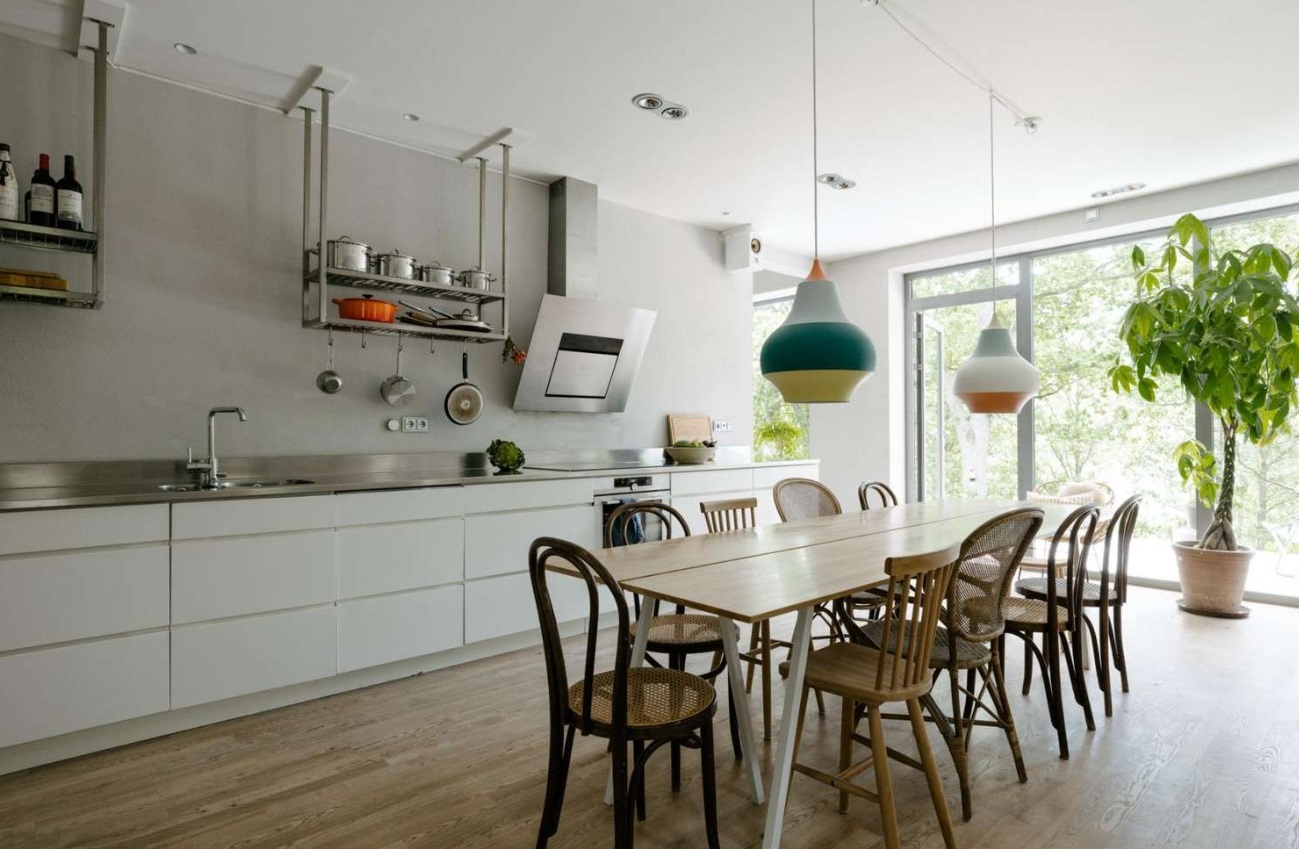
Please focus on the essentials and use colours that exude harmony and sensual materials to make it more casual.
Scandinavian style can be expressed in the kitchen mainly with natural materials. Wood and stone, in particular, stimulate the senses because their look and feel are unmatched.
Stainless steel and refined decoration: kitchen elements from Vipp
Contrast, like a black stainless steel kitchen from Vipp, provides clarity and brings calm to the kitchen. Ultimately, the right accessories make it Scandinavian, such as wooden planks, dried flowers or a rough-knotted wool rug with a rustic structure.
Utility
But more than just the kitchen’s appearance is essential for Scandinavians. Functionality comes first. The kitchen in the north end should be clearly and neatly structured. A simple design with enough storage space for all kitchen utensils is highly desirable. This means that a Scandinavian-designed kitchen is not only a place to cook but also a room where you can meet with family and friends and exchange news in a comfortable atmosphere.
A little style review: What is Scandi Style?
Anyone who has spent winter in Denmark, Sweden or Norway knows it can be dark here for up to 17 hours a day in the winter months. Nowhere else knows better how to equip your home to feel good for your body and mind with precise shapes and natural materials such as wood, textiles and ceramics. Scandi style is not only about trendy furniture styles but also about a holistic and harmonious interaction between controlled interiors, muted colours and the positive and warm effect they have on well-being. You can already find the basic features or elements of the Scandinavian interior trend in your four walls. Otherwise, it would help if you upgraded your kitchen to Nordic style. No room is visited more often than the kitchen, which is the focal point of everyday life. What’s more important is that this room is designed to be closed and exude a comfortable atmosphere.
Modern Scandinavian kitchens are really on trend and are the perfect choice if you value the combination of functionality with straight lines and simplicity. What makes this interior design style unique, and how can you create your dream kitchen quickly and easily? Bright colours, precise shapes, wooden elements and simple accents make the Scandinavian kitchen a special place for well-being.
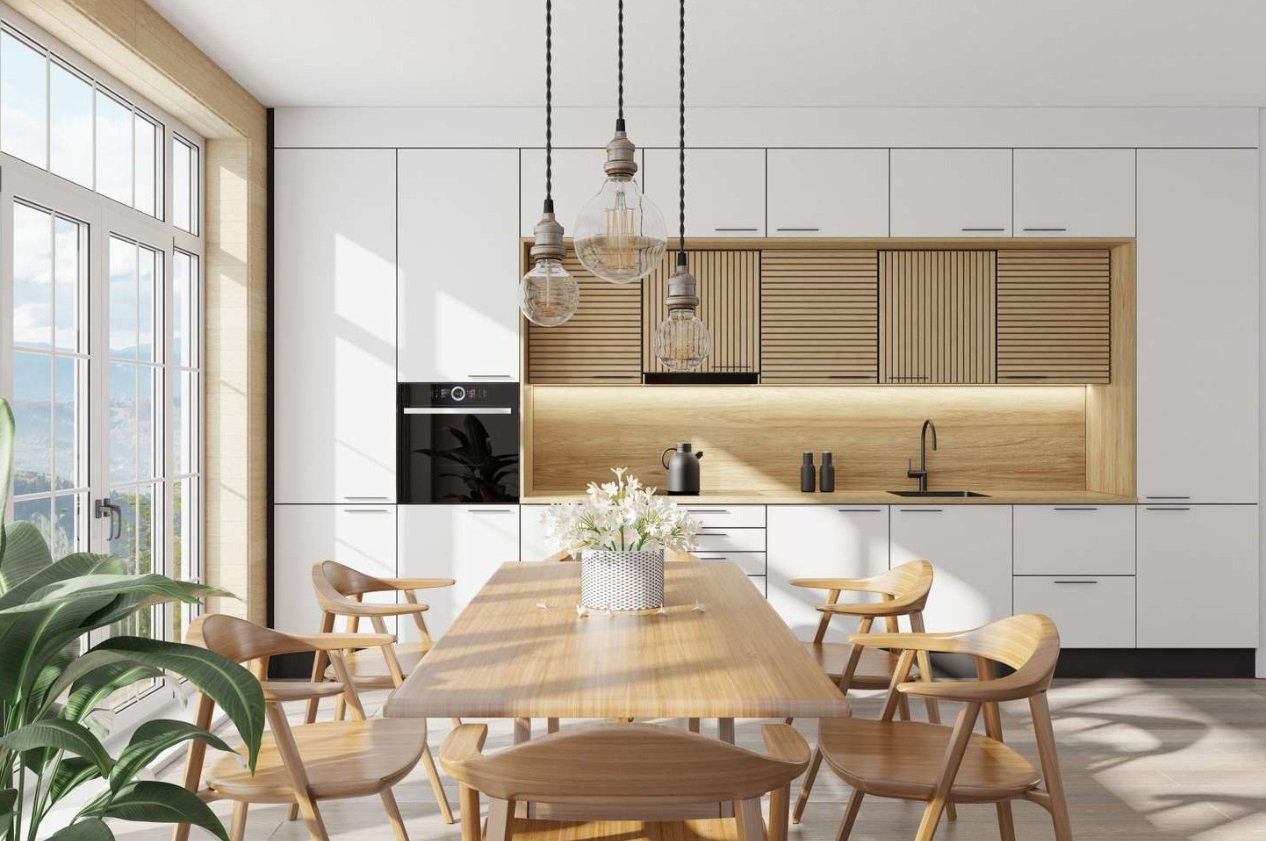
HOW DOES A Scandinavian KITCHEN LOOK LIKE?
If you want to style a Scandinavian kitchen, it’s best to avoid unnecessary frills or frills. Because in keeping with the motto “Less is more”, Scandi style impresses with its clear lines and edges. Instead, the focus is on functionality and enough storage space to create order in the kitchen. For example, a spacious drawer with a soft-close function or a practical Le Mans cupboard.
Scandinavian kitchen – what styles are there?
There are several different options available to bring Nordic calm and comfort into your cooking and dining space:
Classic Scandinavian Kitchen: A classic country house kitchen creates a welcoming and inviting atmosphere. The trendy wooden look, combined with light colours such as white or light blue, and various nostalgic elements, such as the curved handles on the kitchen front and the typical Nordic wall drawings, exude a refined and cheerful charm. Rustic accessories made of stoneware and wicker also highlight the Scandi style.
Modern Scandinavian kitchen: Another variant is pure-looking Scandinavian cuisine. The combination of simple furnishings, handle-free kitchen fronts and colour accents in darker tones is impressive here. According to designer kitchens, grey is popular and creates an elegant atmosphere. Stainless steel appliances can also shine in a timeless Scandinavian kitchen. A kitchen island you can use as a cooking area or a practical kitchen table will look very neat, highlighting the modern style.

Tips for Scandinavian furniture in the kitchen
You now know the important rough data about Scandinavian furniture in the kitchen. Let’s start diving deeper and sharing all the tips and tricks. Make yourself hygge!
1. From grey to smoky blue: Scandi-style colour palette
Calm colours in natural tones and simple lines soothe – not only your own mind but also the room. Whether choosing kitchen furniture, chairs, or wall colours, choose light colours such as white, grey, or light smoky blue. Greige, a warm beige and grey mix, is widespread and can be combined perfectly with black wooden elements, sinks and kitchen fixtures.
2. White dominates
When talking about Scandinavian kitchen colour design, white dominates in various shades. Warm white as a base proves to be a good choice here. Warm white kitchen furniture guarantees warmth and peace; on the other hand, pure white can look airy and fresh. Combining modern kitchen colours, such as light blue, vanilla yellow, or light rose, can create a lovely accent.
3. Ingredients in a Scandinavian kitchen
Wooden raw materials represent naturalness and should be present in a Scandi kitchen. Light untreated wood, in particular, creates a comfortable, original and pleasant atmosphere that invites you to cook, eat and relax. Glossy kitchen fronts with solid wood worktops can also be found in Scandinavian kitchens, providing a modern look.
Of course, the decor also focuses on natural materials such as leather, fur, linen and cotton. If you have an open kitchen, leather-covered chairs for the table or benches with faux fur will attract attention. Wall shelves with woven items, Scandinavian kitchen lamps, Nordic drawings and geometric or graphic patterns and shapes further enhance the Scandi look.
If you prefer something more fun, you can decorate pictures, pillows, etc., with leaves or flower tendrils. Native flowers and plants are essential in a Scandinavian kitchen and provide a surefire treat.
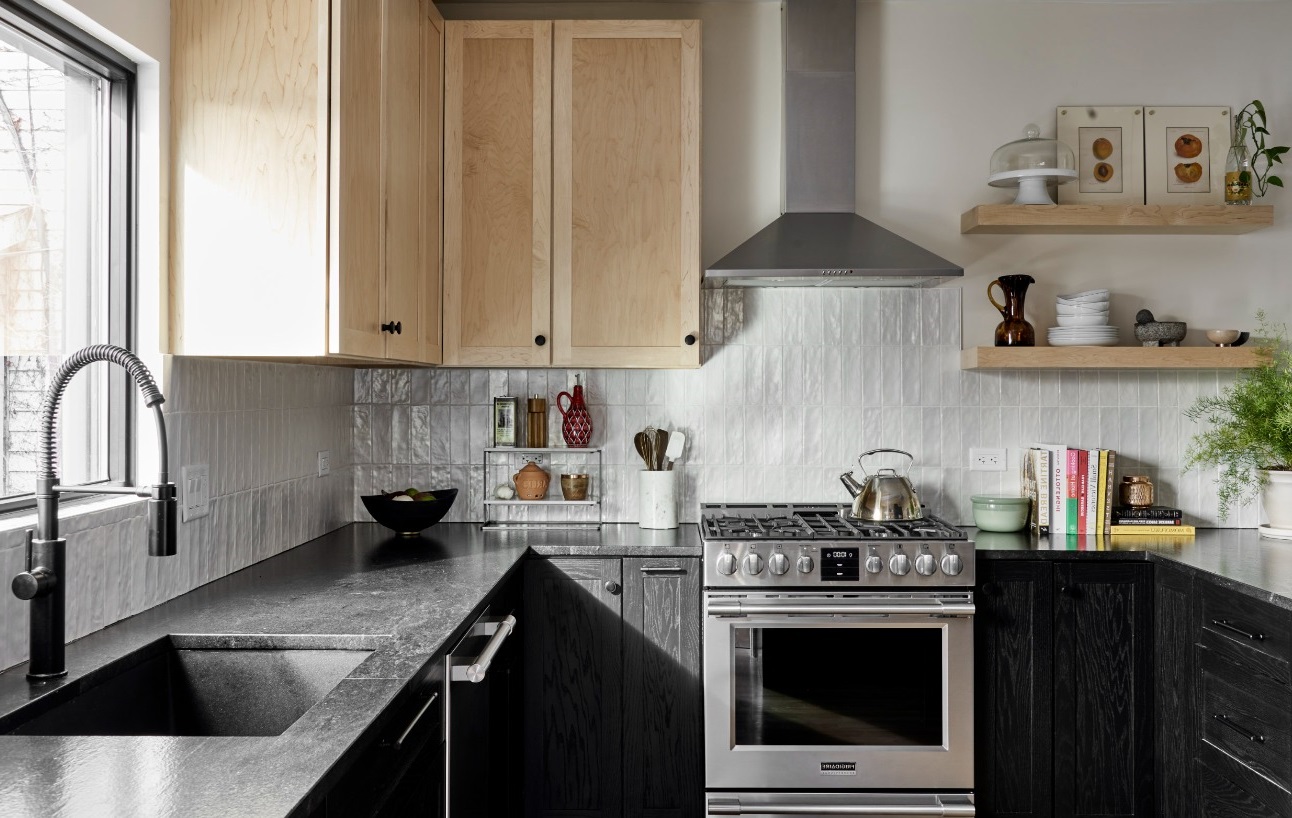
Kitchen furniture for a modern Scandinavian kitchen
Apart from natural materials, the most essential characteristic of a Scandinavian kitchen is a kitchen shape with clear lines and sufficient storage space. There are no unnecessary frills or frills. The following applies here: less is more!
Scandinavian kitchens usually offer other storage space solutions besides cupboards for plates, pans, etc. Spacious drawers, a practical Le Mans cupboard, and a display cabinet ensure an organized atmosphere. Functionality always comes before looks.
4. Household items that create space
Both colour, furniture, and household appliances should demand less attention. Therefore, adequately placed built-in appliances are necessary for a Nordic-style kitchen environment. The fact that not all household appliances are the same becomes immediately apparent when you compare the features of different manufacturers. One thing that stands out in the Scandinavian style is the name of the unique function in which the oven door completely disappears under the cooking chamber when opened. Did you know that wall-mounted extractor hoods are no longer necessary? The induction hob with an integrated extractor sucks out the odours that arise: straight from the hob. With this intelligent solution, you can create space in no time.
5. Scandinavian kitchen table ideas
Wood plays a vital role in the Scandi style. That’s why many people choose work desks made of solid wood (for example, oak or beech). Wood is a natural, renewable raw material that creates a pleasant indoor climate. In addition, the surface and structure of the solid wood kitchen table are also unique. Thus, you get a truly unique piece for your kitchen!
Of course, you are not tied to a wooden table. Kitchen tables made of natural stone also fit nicely into Scandinavian kitchens. A kitchen table made from revolutionary materials such as Dekton or Neolith will look elegant.
6. Decorate in a clean Nordic way
The interior experts at Studio Wohnglück have taken the Scandinavian look to the extreme in their founder’s renovated home: two minimalist wall lamps in Nordic Clean Style illuminate the work desk and decorate the walls with their serene design.
Like the lighting, they rely on the Nordic label for kitchen chairs with curved backs. Small, symmetrical patterns on pillows, cloth napkins, or placemats fit perfectly into the Scandinavian style. High-quality handcrafted ceramics bring authentic, nature-loving Scandinavian charm to the dining table. Colour should also be present in a modern Scandi-style kitchen.
Our tip: A table or worktop made of terrazzo brings life and structure to the look of a Nordic kitchen.
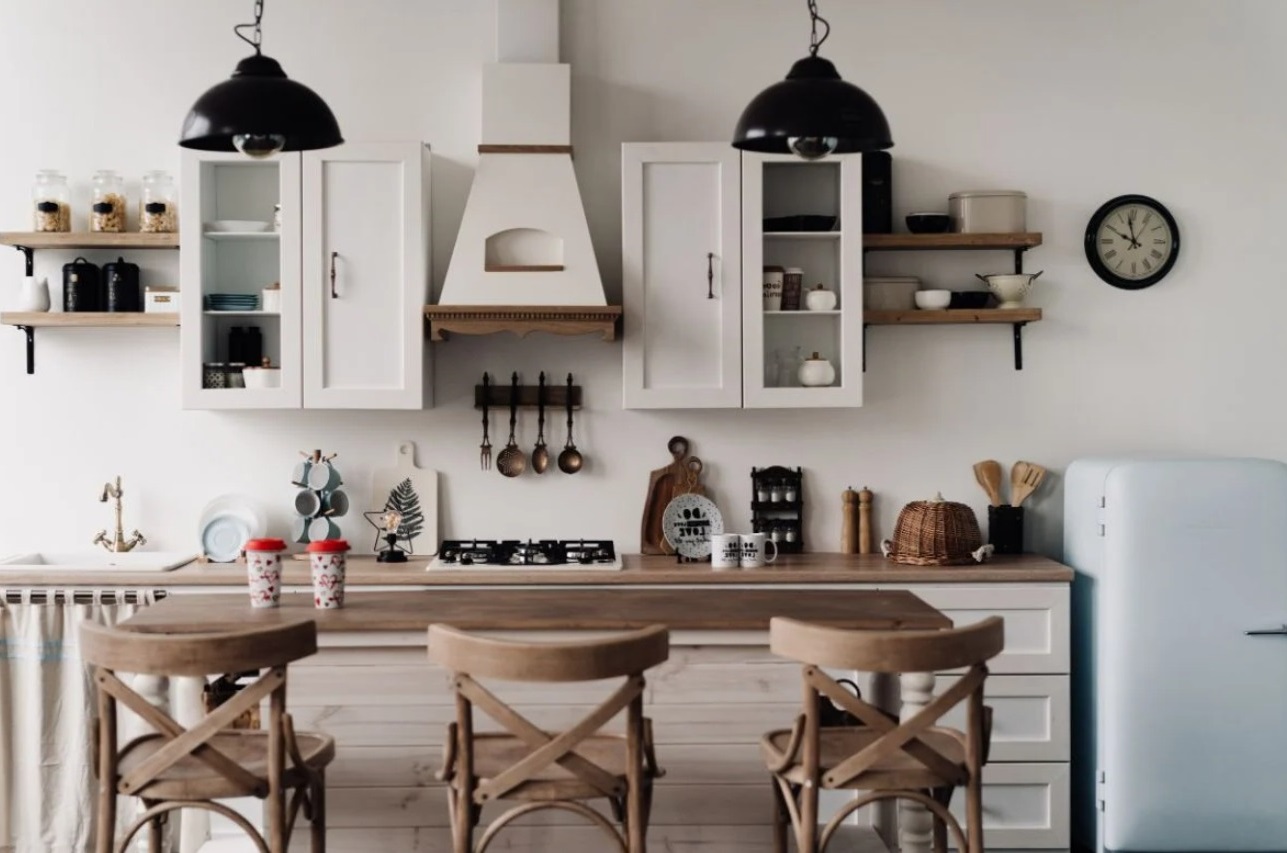
Ideas for more comfort in the kitchen
The bloggers know how to make the most of every room and reveal how your Scandi kitchen can be a happy place.
Sitting in the kitchen by the fire and watching your favourite person cook? Oh yes! A real fire with a cozy crackling sound in the fireplace complements an authentic Nordic interior. You can’t get more comfort, warmth, and fun factor!
A hack that not only pleases guests but also turns your everyday lunch or dinner into an experience: the warm plate on which the dish is served. Doesn’t that sound like a big deal? But, for the sake of the new warming drawer, you can enjoy taking the time to plate beautifully in everyday life and in large groups and celebrate our food as never before. The warming drawer has opened up new possibilities for you. To match the oven, the warming drawer also comes in an elegant grey colour and is placed directly under the stove.
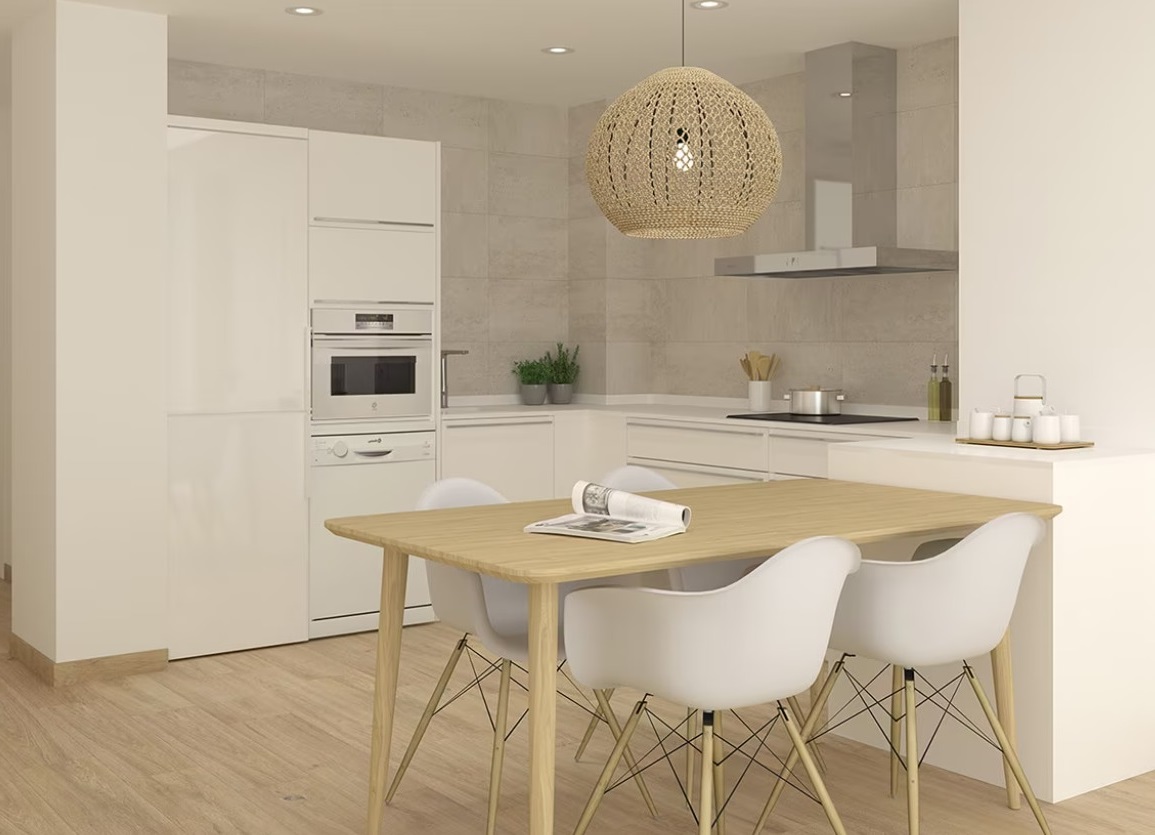
Interesting facts & frequently asked questions.
What defines the Scandinavian style?
Scandi style impresses with its functionality and straightforward design. Its characteristics include lots of storage space, fresh colours, and the kitchen as the living room’s focal point.
How is the Scandinavian style right for me?
Do you like nature and natural materials, or do you enjoy holidaying in northern latitudes? Then, the Scandinavian design will delight you.
Cooking with Hygge: Tips for your Scandinavian design
Minimalist and neat kitchen
Scandinavian style became popular in the 1950s but is still a trend in interior design today.
Cooking, frying, baking—the kitchen’s main function matters. Even so, it can also be transformed into a comfortable place. Just follow the following inspiration for the initial setup and redesign.
Wood: This natural material brings warmth and character to the kitchen area as a worktop, sideboard or cupboard. Combined with glass and stainless steel, it gets a modern touch.
White and grey: Light colours are the perfect base colours for kitchen fronts and areas. The white-coated wooden surface looks very elegant.
Soft and rounded: Chairs, tables and decorative elements should have smooth contours.
Simple is beautiful: Use some accessories that are important to you. At most, they have additional functions.
Light sources: Lamps and ceiling chandeliers should provide the warmest light possible. Place several small lights in the room to create a comfortable nighttime atmosphere.
Practical and beautiful: Emphasize beautiful accents even in the details and choose towels with soft colours, matching patterns and motifs.
5 Steps to Attain the Ideal Scandinavian Style Kitchen Design
Are you envisioning a sleek and minimalist kitchen design that radiates warmth and comfort? Look no further than the Scandinavian style! With its focus on simplicity, functionality, and natural elements, the Scandinavian style has become a favored option for homeowners globally. In this guide, we will walk you through the 5 steps to achieve the perfect Scandinavian style kitchen design.
Step 1: Use Light and Airy Colors – The primary approach to creating a Scandinavian kitchen is to utilize light and airy colors. Choose crisp whites, gentle grays, and soft pastels to establish an open and inviting space.
Step 2: Embrace Natural Materials – It is crucial to incorporate natural materials like wood and stone to achieve that classic Scandinavian look. Consider integrating wooden cabinets, countertops, and flooring to create a warm and natural ambiance.
Step 3: Opt for a Streamlined Design – Keep the design uncluttered and simple. Invest in sleek and practical furniture, cabinets, and appliances to establish a seamless and efficient workspace.
Step 4: Introduce Cozy Textiles – The addition of cozy textiles such as sheepskin throws, rugs, and curtains can instantly infuse warmth and texture into your Scandinavian kitchen.
Step 5: Bring in Greenery – Invite the outdoors inside by adding some greenery to your kitchen. Potted plants and fresh herbs not only introduce a natural touch but also help purify the air.
By following these 5 steps, you will be well on your way to achieving the perfect Scandinavian style kitchen design. Get ready to cook in a space that is both stylish and functional!
Key elements of Scandinavian style
Step 1: Utilize light hues and natural elements
To comprehend light in architecture, materials play a crucial role as they affect the quantity and quality of light. Architects use light to emphasize the contrasts between different materials and choose materials that allow them to create a specific distribution of light in a space.
Materials and light are interdependent. A material’s finish and color are the most important qualities that determine how much light is absorbed and how much is reflected. Specular materials, like glossy finishes, reflect light like a mirror, while matte surfaces, such as natural stone and wood, reflect light evenly in all directions. The hue, value, and intensity of a material’s color also impact the amount of light absorbed and reflected.
Changing materials can alter the ambience of a room and the level of light. The most cost-effective way to brighten a dark room is to paint the surfaces white. Conversely, a dark room can be created by using a little light in a white room or through dark surfaces. Dark surfaces make a room appear dark both during the day and at night, while light or white surfaces produce different effects based on the light source used.
Materials evoke emotional responses in relation to light. The gleam of glass, the shine of gold mosaics, the depth of dark polished wood, and the shadows on a white wall convey emotional messages. Some are connected to cultural backgrounds, while others are linked to individual memories. For instance, plaster, with its labor-intensive application process and special materials, over time develops a softer, more moist appearance, exuding an air of fantasy and beauty.
Step 2: Embrace minimalist design concepts
Minimalist design has been popular for decades due to its clean, uncluttered aesthetic. It emphasizes simplicity and can be applied to various aspects of design, including modern interior design. If you wish to incorporate minimalist design principles, consider the following tips to get started.
Begin with a neutral color scheme
Modern minimalist interior design revolves around simplicity, and a neutral color palette helps achieve this. Utilize white, gray, and other muted colors for walls, floors, and furniture to create a calm and serene atmosphere, which is crucial for a minimalist interior.
Opt for simple, clean lines
Minimalism prioritizes simplicity, even in the shapes and lines used in modern interior design. Furniture with straight, clean lines and minimal detailing is ideal for minimalist interiors. Avoid overly ornate or elaborate designs, as they can detract from the overall aesthetic.
Embrace empty space
Negative space, or the space around objects, is a key aspect of minimalist design. In modern interior design, negative space can create a sense of openness and airiness. Leave certain areas of your home empty or use simple decorations to draw attention to specific focal points.
Select purposeful furniture
When choosing furniture for your modern minimalist interior design, consider its purpose. Each piece of furniture should serve a specific function and have a designated place in your home. This approach will help maintain a neat and focused space.
Keep decorations minimal
Minimalism emphasizes simplicity, so when it comes to decoration, less is more. Avoid excessive knickknacks and other decorative items that can clutter your space. Instead, opt for a few simple items that can serve as focal points and complement your modern interior design.
Establish a feeling of organization
In contemporary minimalist interior design, it’s important for everything to have a designated spot and to be well-kept. This entails staying orderly and reducing mess. Use storage solutions to maintain a tidy space, and consider investing in furniture that has built-in storage to maximize your area.
Incorporate elements from nature
Natural materials like wood, stone, and glass are ideal for contemporary minimalist interior design. They introduce a warm, textured ambiance to your space while preserving the simplicity of your design. Look for furniture and decorations crafted from natural materials to add visual appeal to your home.
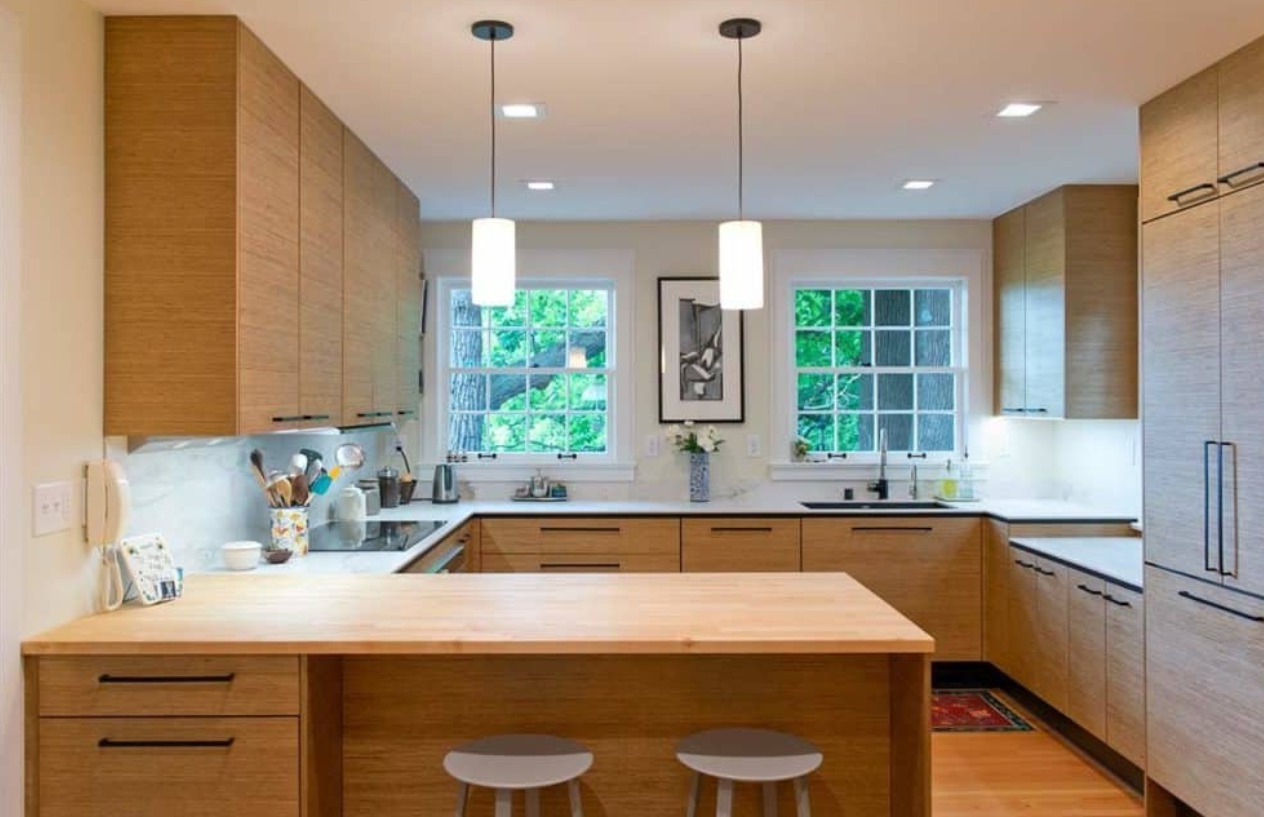
Step 3: Use practical and functional storage solutions
In today’s fast-paced world, it’s crucial to have an organized and clutter-free living or workspace to enhance productivity, decrease stress, and enhance overall well-being. However, achieving and maintaining an organized environment can feel overwhelming at times. We will investigate effective strategies for arranging and tidying your space, enabling you to establish a practical and balanced environment that facilitates your everyday tasks. From intelligent storage solutions to effective decluttering strategies, we will guide you in creating a more organized and peaceful space.
Assess Your Space: Begin by evaluating your space and identifying areas that require organization and decluttering. Step back and carefully assess each room or area. Determine which items are essential and which can be relocated or stored elsewhere. This initial evaluation will provide a clear understanding of where to begin and what organizational systems may be necessary.
Decluttering Methods: Employ a decluttering method that aligns with your needs and preferences. One popular approach is the KonMari method, which involves categorizing items and only retaining those that bring you joy. Another method is the “Four Box Method,” in which you designate boxes for items to keep, donate, sell, or discard. Find a decluttering method that suits you and enables efficient decision-making about your belongings.
Optimize Storage: Invest in intelligent storage solutions to maximize space and maintain organization. Use shelving units, storage bins, baskets, and drawer dividers to establish designated areas for specific items. Make the most of vertical space by installing wall-mounted shelves or using under-bed storage. By assigning each item a specific place, you will reduce clutter and simplify the organization of your space.
Implement a System: Establish an organization system that suits you and your lifestyle. Whether it’s organizing items by category, using color-coded systems, or implementing a labeling system, find a method that ensures easy access and efficient retrieval. Ensure that other household members or colleagues are aware of the system to maintain consistency and collaboration.
Utilize Concealed Storage: Maximize your storage capacity by utilizing concealed storage solutions. Choose furniture with built-in storage, such as an ottoman with hidden compartments or a coffee table with drawers. Consider using wall-mounted shelves, hanging organizers, or making use of the space under your stairs for additional storage. Concealed storage helps maintain cleanliness and order while providing ample space for your belongings.
Regular Maintenance: Organization and cleaning are ongoing processes. Establish a maintenance routine to prevent clutter. Allocate specific times to clean and tidy specific areas. Make it a habit to regularly purge unnecessary items to maintain a neat and clutter-free space.
Organizing and decluttering your space is a transformative process that enhances functionality, reduces stress, and improves overall well-being.
Step 4: Utilize natural light and greenery
Expert interior designers utilize the influence of natural light and greenery to enhance your home design, drawing inspiration from lush natural surroundings to boost creativity and productivity. The following are ways in which interior designers incorporate natural light and greenery into your home design:
- Implementation of Large Windows and Skylights:
Interior designers understand the significance of abundant natural light and therefore incorporate large windows and skylights in office spaces to maximize sunlight penetration. These features not only flood the space with natural light but also provide inspiring views of the surrounding landscape, creating a more welcoming and productive environment.
- Thoughtful Space Planning:
Efficient space planning is crucial to ensure that natural light reaches every corner of your home. By carefully arranging the sofas in the living room and family room, sunlight blockage can be minimized. This strategic layout enhances functionality while making the most of natural light.
- Use of Reflective Surfaces:
To amplify the impact of natural light, reflective surfaces such as mirrors, glass partitions, and light-colored upholstery can be utilized. These surfaces reflect light throughout the home, creating a brighter and more open atmosphere.
- Incorporation of Biophilic Design:
The concept of biophilic design, which integrates nature into the home, is gaining prominence. Indoor plants, natural materials, and nature-inspired elements are incorporated to bring the outdoors indoors, promoting well-being, creativity, and satisfaction.
- Green Walls and Vertical Gardens:
Green walls, also referred to as living walls, are indoor vertical gardens that thrive indoors. These features can be incorporated to introduce a touch of nature to your home’s interiors. Green walls not only purify the air but also create a visually stimulating and calming environment.
Step 5: Infuse subtle Scandinavian design elements
Here are some ways to infuse subtle Scandinavian design elements into your home:
Incorporate natural elements
Use natural materials such as wood, stone, and wool to infuse warmth and texture into your space. Additionally, adding potted plants can enhance air quality and create a more serene environment.
Utilize light neutrals
Scandinavian design often incorporates light neutrals and soft dark hues reminiscent of the Nordic landscape. Adding light pastels like rosy pink, pale blue, and mint green can introduce warmth and a soft personality.
Incorporate cozy textiles
Incorporate cozy textiles like wool and sheepskin to establish a calming and inviting atmosphere. Additionally, adding throw pillows in soft colors can soften the bold wood elements.
Introduce geometric patterns
Soft geometric patterns can be introduced through textiles such as throw pillows, rugs, or wallpaper.
Utilize functional storage
Scandinavian design emphasizes practicality, particularly in terms of storage. Utilizing high-pressure laminate can create sleek and durable storage units.
